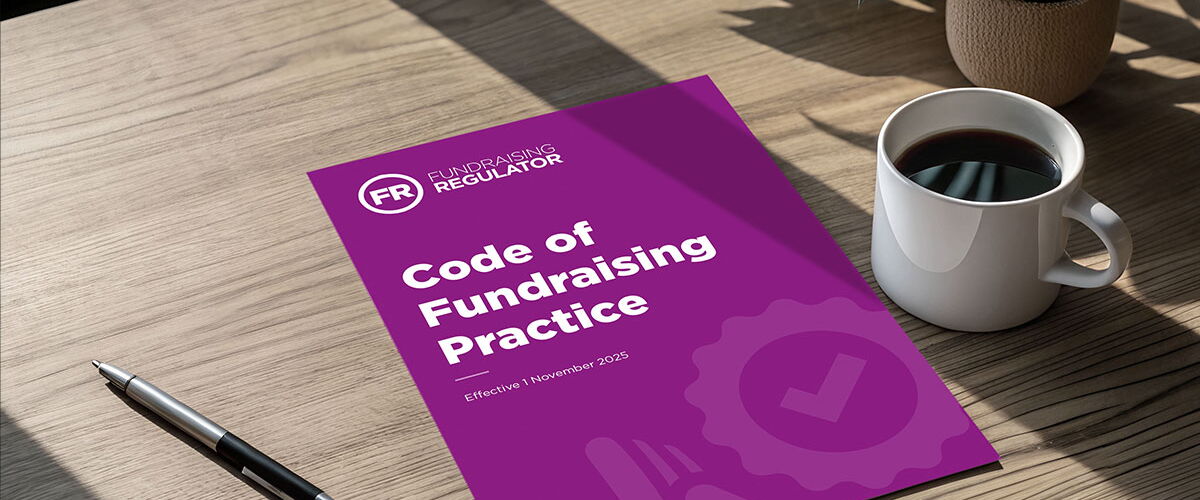Client news
New Code of Fundraising Practice 2025 Summary

Moving towards greater flexibility, ethics and accessibility
There’s a lot to digest in the New Code of Fundraising Practice 2025 which comes into effect later this year, on 1 November. The Fundraising Regulator’s recent publication is the first major update since 2019 and compliance is obligatory for all UK charities.
To help you unpack the New Code, we’ve created a helpful 12-point summary of the main revisions.
1. Principles-Based Framework
- The 2025 Code has moved away from prescriptive rule-based compliance to a principles-based model. In practice, this means the new code no longer links to specific legislation and many rules have been combined under wider principles.
- The code now uses terms like "appropriate," "reasonable," and "proportionate", requiring fundraisers and trustees to exercise judgement in applying standards.
- Fundraising practices must now demonstrate alignment with overarching values rather than strict adherence to exhaustive rule sets.
- This makes the code more flexible, proportionate to organisational size and risk, and better suited to future developments in fundraising.
2. Reduction and Consolidation of Rules
- The new format emphasises clarity, simplicity, and easier navigation, supporting better understanding across teams and volunteers.
- Supplementary "Code Support Guides" (CSGs) and practical examples now aid interpretation.
3. Enhanced Governance and Trustee Responsibilities
- There is an increased emphasis on the strategic role of trustees in overseeing fundraising risk, ethics, and reputation management.
- Trustees are now explicitly required to document decisions regarding accepting/refusing donations, due diligence, and use of funds.
- Governance standards require a clear and accessible complaints procedure, and policies for whistleblowing and concerns.
4. Due Diligence Standards
- There is a new requirement for ‘appropriate and proportionate due diligence’ (rule 2.2.2) before accepting donations, based on the size, source, and nature of the gift. Appropriate and proportionate will vary depending on the size d nature of donation relative to the usual fundraising activity of the charity. For example, it is often appropriate and proportionate not to conduct due diligence on small gifts, some due diligence on larger gifts from known sources, but thorough due diligence should be conducted on large and unknown gifts, particularly from uncommon sources such as loans, crypto-assets or other unusual donation methods relative to the charity.
5. Transparency on Donation Use
- Stronger rules require charities to:
- Clearly state secondary purposes for fundraising campaigns. Specifically, when raising money for a restricted purpose, you must provide information on what will happen if you raise less, or more, than the target. One way to overcome this is to include a ‘secondary purpose’ when asking for donations explaining how funds will be used in this instance.
6. Safeguarding and Inclusion
- Expanded requirements for working with:
- Children, including limits on who can collect donations and how their data and images are used.
- People in vulnerable circumstances, including explicit bans on taking advantage of diminished capacity or trust, and requirements to return donations where capacity is lacking.
7. Volunteer Fundraising
- Clearer expectations for in-aid-of vs on-behalf-of volunteers, including:
- Training requirements,
- Transfer processes for funds,
- Use of appropriate terminology ("in aid of"),
- Due diligence for volunteer suitability.
8. Data Protection and Direct Marketing
- Greater integration with GDPR-compliant practices, including:
- The requirement for consent when sharing or selling donor data for fundraising and direct-marketing purposes,
- Explicit guidance on using legitimate interest as a legal basis.
9. Solicitation Statements
- Expanded clarity around when and how paid staff, trustees or commercial partners must issue solicitation statements, particularly when fundraising for their own organisations or related entities.
10. Modern Payment Methods
- Updated guidance on the use of tap-to-donate, unstaffed payment devices, and online platforms, stressing the need for appropriate payment security standards (e.g. PCI-DSS compliance).
11. Gift Aid and Donor Benefits
- Revised guidance on offering benefits in return for donations, including the implications for Gift Aid eligibility and VAT, with links to updated HMRC guidance.
12. Accessibility of Fundraising Communications
- Communications - including websites, donation platforms, and printed materials - must be clear, accurate, and suitable for the intended audience, including people with disabilities.
- Fundraisers are encouraged to meet the accessibility standards for public sector websites and apps, even if not legally required to do so, as best practice.
- There are explicit requirements not to use images or messages that shock or distress people unnecessarily, and to give warnings if such content is used as part of making communications emotionally and cognitively accessible.
- Digital fundraising tools (including websites and donation forms) should meet WCAG 2.1 AA standards as a minimum.
- Print and in-person communications should offer alternatives like large print, easy-read formats, or support in other languages/formats where feasible.
You can find out more about the New Code on the Fundraising Regulator’s website, or get in touch if you need advice on how to build the updated guidance into your fundraising strategy.
